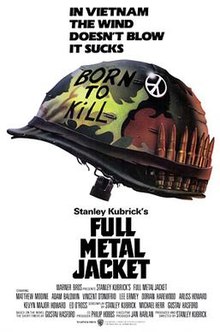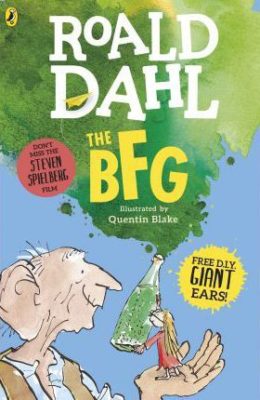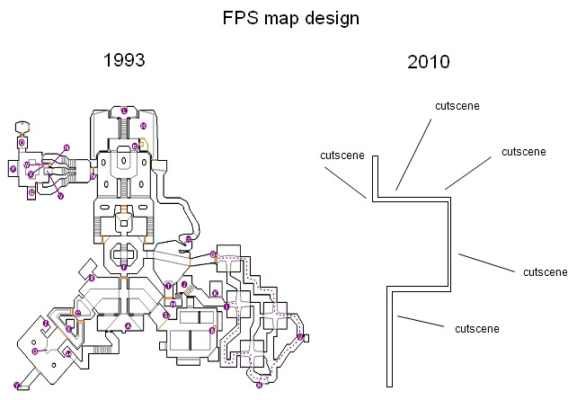Fire a .22 round and a casing will go plink on the ground. If you pick up this casing, clean it, crimp it, fill it with powder, and seat a new primer and bullet, it will be as good as new.
But when you fire and reload the same casing ten or twenty times, eventually it will not be good as new. The metal will become embrittled, prone to cracking and spalling; the walls will be thin, fluxed outward by temperature and pressure; the primer might no longer sit properly; and it will be liable to misfire. There’s variability both in material – in general, brass casings handle repeated firing better than steel or aluminum ones – and in individual casings. Either way, metallurgy will distort your casing past the point of no return. You can never unfire a bullet.
Gunfire changes bullets. It also changes the men firing them. It’s a common pop culture conceit that war irreversibly transforms men – hauls them across an event horizon to sub- or super-humanity. Veterans return to their families and they’re not the same: they quiver and twitch, they’re prone to explosions of anger. Audy Murphy is the US Army’s greatest war hero, credited with 240 kills. He came back a post-traumatic stress case who slept with a gun under his pistol – a gun he would use to threaten and terrorize his first wife. She’s lucky his kill count isn’t 241.
Full Metal Jacket is a latter-day Kubrick film about the above transformation. It depicts the lives of several soldiers (or rather, aspirant soldiers) subjected to the furnace of the Vietnam war. Some crack. Others “survive” in biological terms but jettison parts of their humanity. All seem to have lost something in the end.
It’s fifty percent a great movie. Most films are zero percent a great movie, so that’s not bad. But it’s impossible not to watch it without regret: Full Metal Jacket ends up being much smaller than its shadow. If only it were great all the way through.
Nearly everyone agrees which half of Full Metal Jacket is good. The boot camp scenes at the start – focusing on the relationship between a bullying drill sergeant and a fat, clumsy recruit – are as compelling as anything ever Kubrick put to film. They’re hilarious, cringeworthy, raw, and so thematically complete that when they end, it feels like the movie should also end. It’s actually a surprise when it doesn’t.
R Lee Ermey is fantastic, and carries the movie on his shoulders. He struts up and down lines of terrified recruits like a demonic rooster, reeling off pungently vile insults like stanzas of metered poetry. I’ve heard veterans describe boot camp as “the funniest place you’re not allowed to laugh”, and I think about that when Ermey says stuff like “unorganized, grab-asstic pieces of amphibian shit” and “slimy little Communist shit twinkle-toed cocksuckers“, ready to dump all the shit in the sky upon the first private to crack a smile.
How accurate a portrayal of the boot camp experience is this? I remember a discussion on IMDB’s defunct comments bored – half the vets were saying “This is fantasy” and the rest were saying “This was my experience, exactly.”
Certain things seem right, based on what I’ve heard from friends. Dumping a recruit’s entire kit all over the floor because one little thing isn’t squared away. Punishing an entire class for one recruit’s screw-up. These scenes have a ring of truth. Ermey’s behavior has a cruel kind of logic behind it: he’s weeding out “non-hackers”. In his mind, if you’re going to snap under pressure, you might as well do it at Parris Island, rather than in the field, when the lives of your brothers are on the line.
Vincent D’Onofrio also inhabits his role well: that of a helpless wide-eyed frog getting smashed to pulp by a baseball bat. After weeks of abuse, his eyes start changing, and the drill instructor thinks he’s finally taking instruction. Movie viewers, of course, are aware of dramatic arcs and might guess that something else is coming.
Later, when Joker graduates boot camp and goes to Vietnam, the movie literally loses the plot. None of its events are motivated by anything much. It grinds out some new ideas and characters, but next to D’Onofrio and Ermey’s dynamic they’re not interesting or memorable. I don’t seem to be alone in that assessment. On the film’s IMDB page, the top-voted quotations are overwhelmingly from the early scenes. Down the bottom you’ve got lines spoken in Vietnam by guys I don’t even remember being in the movie.
These scenes are tonally inconsistent. The part where Joker has to write propaganda (“we have a new directive from M.A.F. on this! In the future, in place of “search and destroy,” substitute the phrase “sweep and clear”!) is straight out of Dr Strangelove. Then there’s a moment where a gullible soldier has his wallet stolen by a wacky karate-chopping Vietnamese street gang. Other scenes play their material very straight, without a hint of satire.
A lot has been written about Vietnam, and the way it reflects the final destruction of Clauswitz’s notions of war. No more battle lines. Your enemies dress like civilians. They use women and children, forcing you to make terrible decisions. Your fellow soldiers behave barbarously. Up is down and left is right. You want to escape, but even when you do, the war follows you home, haunting you. What’s it all for?
Kubrick’s film starts out purposeful and ends confused, muddled, and existing just to exist. In this sense it’s the perfect depiction of the Vietnam war.
No Comments »
The BFG is a masterly masterwork of masterism, sublime in every way. The prose glides like a lubed-up manatee sliding face-first into a woodchipper. The drama makes my heart race like a 3.9 gHz Ryzen 7 3800x overclocked to 4.0 gHz for faster frame-to-screen time. The plot clicks like a Kalahari Bushman’s tongue pronouncing the word “!Xóõ”. It’s as re-readable as an affidavit when you’re a lawyer billing $800 an hour and the jury has crippling amnesia.
Also, it’s the only book that caters to my fetish: elderly 24-foot-tall men farting on people.
For a few moments, the Big Friendly Giant stood quite still, and a look of absolute ecstasy began to spread over his long wrinkly face. Then suddenly the heavens opened and he let fly with a series of the loudest and rudest noises Sophie had ever heard in her life. They reverberated around the walls of the cave like thunder and the glass jars rattled on their shelves. But most astonishing of all, the force of the explosions actually lifted the enormous giant clear off his feet, like a rocket.
Sometimes I have this dream. The BFG is climbing through my bedroom window, bearing his horn. There’s a mischievous twinkle in his eye. You can’t tell anyone, the twinkle says. This is our little secret. I hear his stomach gurgling, and it merges with the blood thundering in my ears as he unbuttons his bum-flap, two feet from my face, and…
…I’m oversharing. Sorry. My therapist tells me that I overshare. But how can I not? There’s SO MUCH left to tell…
I hope the BFG doesn’t get cancelled, because he’s one of Roald Dahl’s most politically progressive characters. He’s a vegetarian. And a pacifist! He’s even an anti-capitalist (he turns down a lucrative zoo gig, because he knows the zoo industry is rife with exploitation).
Yes, he’s had problematic moments – he participates in human trafficking, is party to an imperialist invasion, and says that Greek people taste bad – but cut him a break. Nobody’s perfect, and he’s trying his best. When Trump was elected he would have been out marching in the street, wearing a pussyhat the size of a bumbershoot. He would have #FeltTheBern. He would have put a black square on his Instagram. He would have bullied a YA author to suicide.
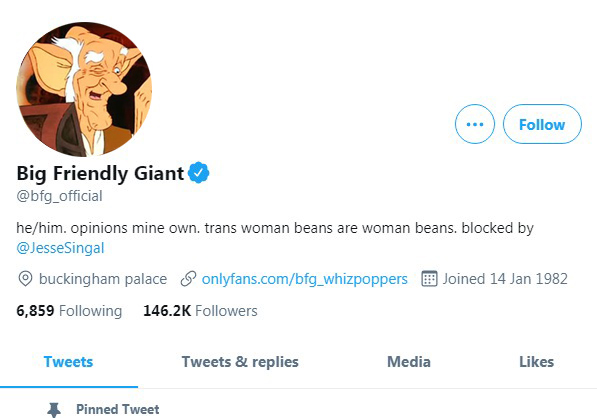
I’m curious, why did the BFG become so sensitive, so unlike the other giants?
His height might play a role. As I’ve mentioned, he’s 24 feet tall. This is small for a giant – the others are described as being 50 feet tall – and this could have sculpted his aesthetic sense.
Most beautiful things in nature are small, and when you’re large you tend not to see them. For example, the 24-foot-tall BFG sees roses that are 4x smaller than our roses. The 50-foot Bloodbottler sees 8x smaller roses. They’d just be tiny specks of color, he’d have to squint to see the petals, and he certainly wouldn’t be able to smell their scent. It’s a sad life, and I rather feel for the Bloodbottler.
It makes you wonder how much we’re missing out on by being as big as we are. Sand is actually quite pretty under a microscope. Due to our size, we just see a gritty, coarse gray, all the colors blending together and cancelling out. But imagine being a 1 millimeter human, wandering through a sea of beautiful jewels. Perhaps there’s a diatom squirming between the grains. You could sling a leash around it, and have a diatom for a pet. Wouldn’t that be neat?
Topic shift: how much food do giants eat?
According to the BFG, giants devour a couple of humans every night.
‘That means,’ said Sophie, ‘that somewhere in the world, every single night, nine wretched people get carried away and eaten alive.’
‘More,’ said the BFG. ‘It is all depending, you see, on how big the human beans is. Japanese beans is very small, so a giant will need to gobble up about six Japanese before he is feeling full up. Others like the Norway people and the Yankee-Doodles is ever so much bigger and usually two or three of those makes a good tuck-in.’
Is this realistic? How many people would a 50 foot tall giant need to eat?
First, let’s make some assumptions.
- The average human is 6 feet tall and weighs 200 pounds
- The giants are humans scaled up by 8x but otherwise unchanged
A 6ft/200lb man has a basal metabolic rate of 2226, and eats 2,671 calories a day (if you’re curious, the 20% difference is caused by thermal inefficiency – your stomach doesn’t perfectly convert food into energy, which would break the second law of thermodynamics.) Klieber’s Law states that the metabolic rate of a endothermic homeotherm (such as a giant) scales as M^3/4, where M is mass. Also, remember that mass increases as a cube of length, so an 8x man would weigh 102,400lb (8^3*200), for a 512x increase in overall mass. 512^3/4 = 107.63, so the giants have a BMR of 239584.38 (2226 * 107.63), and need 287,501.256 calories per day (239584.38 * 1.2).
The human body contains 130,000 calories (according to someone on Quora whose sums I didn’t check), meaning the BFG’s estimate of 2-3 large humans per giant per night is…
…spot on. Either Roald Dahl guessed with surprising acccuracy, calculated it himself, or knows more details about the giant digestive tract than haunt my forbidden midnight fantasies.
However, there are some scientific issues with the book. An egregious example: 24-foot men can’t fly by farting. More interesting is the notion that humans taste different depending on where they come from.
‘But do these disgusting giants go to every single country in the world?’ Sophie asked.
‘All countries excepting Greece is getting visited some time or another,’ the BFG answered. ‘The country which a giant visits is depending on how he is feeling. If it is very warm weather and a giant is feeling as hot as a sizzlepan, he will probably go galloping far up to the frisby north to get himself an Esquimo or two to cool him down. A nice fat Esquimo to a giant is like a lovely ice-cream lolly to you.’
‘I’ll take your word for it,’ Sophie said.
‘And then again, if it is a frosty night and the giant is fridging with cold, he will probably point his nose towards the swultering hotlands to guzzle a few Hottentots to warm him up.’
‘How perfectly horrible,’ Sophie said.
‘Nothing hots a cold giant up like a hot Hottentot,’ the BFG said.
Clearly, the giants are falling prey to the placebo effect.
In Frédéric Brochet’s infamous 2001 wine study, wine tasters were unable to distinguish between red wine and white wine that had been dyed to look red. Suggestion is a powerful thing. Eskimos live in a cold place, so the BFG expects them to taste cold. Wales sounds like the word whales, so the BFG expects Welsh people to have a fishy taste. He’s not to blame. He’s a prisoner of the Sapir-Whorf hypothesis. I wonder if the snozzcumbers really do taste bad, or if the BFG has been primed to assume a bad taste because of their disgusting name.
Lastly, the giants are made of a weirdly light substance.
In Quentin Blake’s illustrations, we see captured giants being airlifted by the British RAF (this brutal and unprovoked attack on a sovereign country would later be condemned by the International Court of Justice, and played an important role in Margaret Thatcher’s Conservative Party being voted out in the 1990 election. They don’t show you that part in the book.)
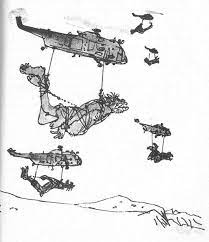
From the shape, these helicopters appear to be the Westland Sea King, which has an unloaded weight of 6,387kg and a maximum takeoff weight of 9,707kg. So the giants, incredibly, weigh less than four metric tons, not the 46 tons I calculated above. It’s very odd.
Either that or the British RAF maintains a fleet of mega-sized Sea Kings, just in case such an event occurs. I’m going to bed. Perhaps I’ll have the dream again. I’ll keep you posted.
No Comments »
What’s the worst trend in gaming?
I don’t know. But the most inexplicable trend is the game that doesn’t want you to play it.
You are led by the nose down a path, having scripted experiences. Every choice has been made for you in advance. Stray from the path and you’re corralled back in by invisible walls or flashing “RETURN TO THE BATTLEFIELD” messages. Cutscenes are immensely long: you spend half the game with your inputs disabled.
Any “interactivity” is inconsequential: you can choose from two paths in the road, but both lead to the same destination. You can choose from two options in an NPC dialog tree, but the conversation ends the same way every time.
…Doesn’t this defeat the whole purpose of a videogame? Being able to explore and interact and express agency? Games lose a lot when they’re reduced to booklike narratives where the player’s “actions” are just fancy ways of turning the page.
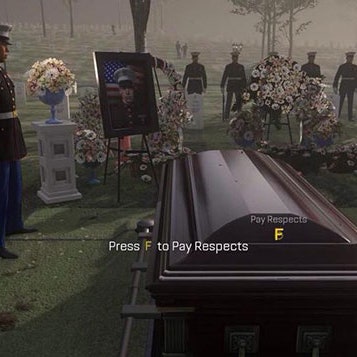
This is not a “games were better in my day!” rant. The worst offenders in this category are actually classic games, particularly the adventure games of the 80s and 90s.
Remember adventure games? Like The Secret of Monkey Island and Leisure Suit Larry? Remember how, around 1995-1996, everyone suddenly stopped playing them?
“The death of adventure games” was a popular journalistic brief in the late 90s. Writers filed many a column inch about why adventure titles weren’t selling, and why the old guard of developers (Sierra/LucasArts/Trilobyte) were either shifting focus or filing for bankruptcy.
Always, an outside factor is blamed for killing the genre. Adventure gamers love Lost Cause myths where their beautiful, pure genre were ruined by Myst and Doom and Nintendo and arcades. Nobody wants to admit that the rot started within.
Here’s the truth: most adventure games (aside from a short list of classics) were actually total shit, full of illogical puzzles, mazes, pixel hunts, fetch quests, and arbitrary deaths. Here’s the average puzzle in a text adventure:
You are hungry! You find a HAM SANDWICH and a
TURKEY SANDWICH. What do you do?
>EAT HAM SANDWICH.
You are dead! It was a POISON HAM SANDWICH! Should have gone with the turkey, dumbfuck! Load save Y/N?
That’s not a strawman. Half the games Infocom ever made were exactly like that.
Just because I love you, here’s a real example from Westwood’s critically-acclaimed The Legend of Kyrandia, which sold quarter of a million copies in 1996.
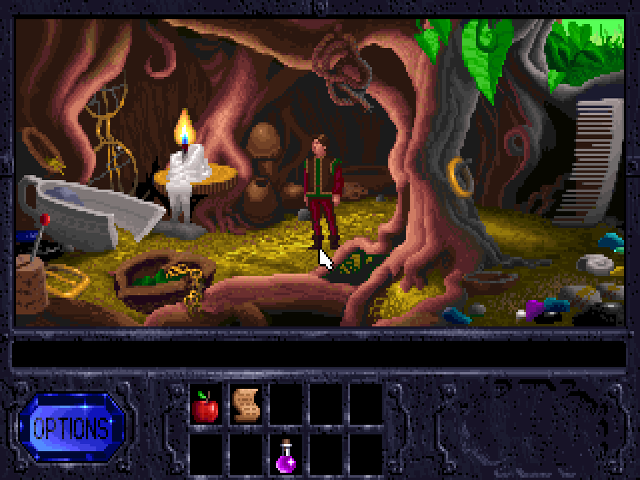
Imagine this:
You are standing outside a house, looking down into a lake. You see a pair of eyes in the water. When you approach the water’s edge to get a better look, a huge monster rises from the water, snatches you with its tongue, and reels you into its mouth. Crunch.
Terrible. A whole Full Sail game design course could be taught about how utterly bad this puzzle is, in every conceivable way.
There’s no warning of danger, no possibility of escape, and the outcome for the player is death. There’s no skill involved: you just have to know not to follow the eyes. And since you can’t anticipate the next death trap (which there are a lot of), you end up creeping around Kyrandia like a scared mouse, hoping you don’t step on any Instant Death Pixels(tm).
The Legend of Kyrandia actively penalizes you for playing it. Exploring? Taking risks? That’s not in the plan. Stick to the main path, friendo, and do what the game wants you to do.
This design approach is great from the developer’s point of view. You spend less time designing art assets and playtesting puzzles. Your games ship sooner, and have fewer bugs. Open-world games with a lot of options quickly turn into a garden of forking paths. But in the long run, you get a constrained experience.
It’s interesting that the big genre shifts of the past few years have included open-world exploration games like Minecraft, and battle royales like Fortnite and Apex Legends. These are games where every experience is different. It’s not a surprise, in hindsight. Players, by definition, want to play. They don’t want to be conscripted characters in someone else’s story, and that’s exactly what many major games are.
I’ve long felt that the “are videogames art?” debate elides the obvious point that the “art” of videogames is usually just cinema, at best. Playing a Triple-A game is largely indistinguishable from watching a movie. The strongest claim games can make to being an art form are titles like Cosmology of Kyoto and Rez…
…obscure, nice products that nobody’s heard of.
No Comments »

